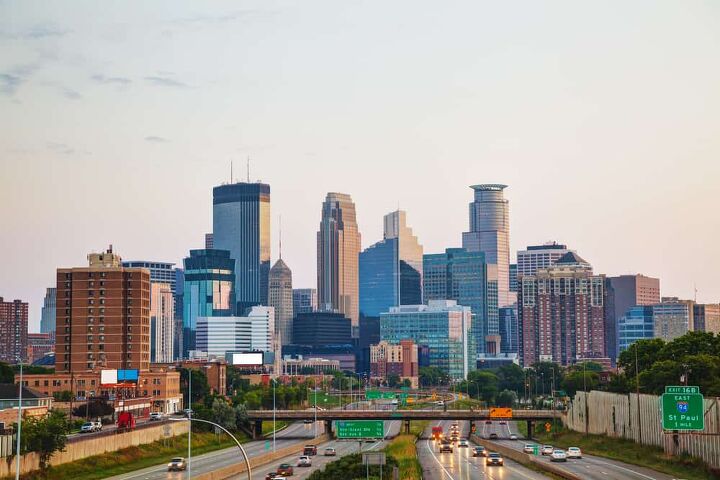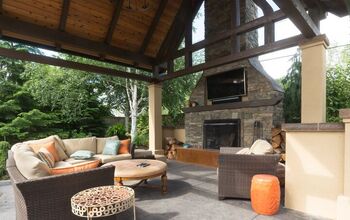15 Most Dangerous Neighborhoods In Minneapolis

HarMinneapolis is the county seat of Hennepin County and is considered the largest city in Minnesota. It is a city that started and grew based on the nearby sawmills and flour mills. The first significant military presence, Fort Snelling, also increased residency in the area. The city grew to have approximately 83 neighborhoods, all with their own culture and economic structures.
According to FBI statistics, the most dangerous neighborhoods in Minneapolis are Hawthorne, Midtown Phillips, Harrison, South Minneapolis, and East Phillips. These areas routinely have the highest rates of violent and property crimes per capita in Minneapolis, ranging from 58 to 156% more than the rest of the city. Avoid visiting Jordan, Folwell, Near North, and Central as well.
When Minneapolis is compared to that of other neighborhoods with a similar population, the average crime is higher. The overall crime rate of Minneapolis is 57 for every 1,000 residents, which makes it one of the highest crime rates in the united states. So, if you are moving, visiting, or just driving through Minneapolis, there are some areas that just should be avoided.
How The Most Dangerous Cities Are Determined
There are many factors to consider, like population and home values, when determining the danger of a neighborhood. Rental properties are another critical factor in determining the value of a community. If the majority of the population are renting, the higher the crime rate could be. This is just a factor to keep in mind since turnover rates of occupancy can bring in people that could be up to no good.
Noticeable signs of a deteriorating neighborhood are a lack of storefronts, especially grocery stores and vacant buildings. Empty houses and lots that have been abandoned for months or even years can be a sign the neighborhood is dangerous. Also, if there are multiple fast foods and not enough fresh food or restaurants available, you may want to consider relocating.
Ultimately the estimated crime rates of the area are the primary factor for this determination. However, statistics looking at the average income in addition to the population can also play a major part in the neighborhood’s economy. This can correlate directly to the crime rates making living conditions more difficult.
The Top 10 Most Dangerous Neighborhoods In Minneapolis
We’ve researched the top 10 most dangerous neighborhoods within Minneapolis and discovered this list. Let’s look at some of the neighborhoods and why they’re so dangerous. That way, you can stray away if you move or visit Minneapolis.
1. Hawthorne
- Population: 4,112
- Violent Crime: 3,956
- Property Crime: 10,688
- Total Reported Crimes: 14,644
Named after 19th-century author Nathanial Hawthorne, this neighborhood is located north of downtown Minneapolis. It is bordered by the Mississippi River on the east and is also surrounded by Near North (#3) and Jordan (#4). Looking at the statistics of this neighborhood, it is easy to understand why the crime rate is 75% higher than the national average.
The majority of residents in Hawthorne are renters instead of homeowners; this is more than likely due to the neighborhood’s economy. The average income is almost 50% lower than the national average; however, the overall expenses are 12% higher. Unfortunately, the crime rates are the results of these poor living statistics.
According to FBI records, a total of 14,644 crimes were reported in the 2020 calendar year. Among the offenses committed were everything from murder to auto theft.
In total, there were 3,956 violent crimes and 10,688 property crimes. This data is significant; the crime rate is exceptionally high when compared to the population of 4,122 people.
2. Midtown Phillips
Photo Credit: Streets.MN
- Population: 5,181
- Violent Crime: 3,817
- Property Crime: 6,435
- Total Reported Crimes: 10,252
Midtown Phillips is a neighborhood in Minneapolis’ Phillips neighborhood. It is bordered on the North by East 24th Street, on the east by Bloomington Avenue, on the south by East Lake Street, and on the west by Chicago Avenue.
According to the 2010 Census, the community’s land use is primarily residential, and it has over 4,700 individuals from various backgrounds. The Children’s Hospital of Minnesota Minneapolis site, Abbot Northwestern Hospital, and Allina Healthcare Services are all notable employers.
While the business around here is bustling, so is the crime. In Midtown Phillips, there have been a total of 10,252 crimes reported for the 2020 calendar year. Among them are murder, assault, rape, auto theft, burglary, and other property-related offenses.
Property crime outnumbers violent crime. There were 3,817 violent crimes and 6,435 property crimes reported. All of this occurred in a community with a population of 5,181 people.
3. Harrison
- Population: 3,491
- Violent Crime: 3,214
- Property Crime: 6,906
- Total Reported Crimes: 10,120
Located to the west of downtown Minneapolis, Harrison is a neighborhood known as the location of Prince’s childhood homes. Harrison is a diverse community with a strong cultural history; however, 37% of residents live in poverty. The school system does maintain an average rating.
The area suffered from restrictive housing practices in the mid-1900s, and the population is still reflective of those practices. Average housing costs in the area are slightly higher than the national average. Regardless though statistically, 66% of households in the area are rented rather than residents owning their own home.
In the year 2020, there were 10,120 crimes reported in Harrison. Murder and rape, as well as burglary and property theft, were among the crimes reported.
At the time, property crimes outnumbered violent crimes. Property offenses were 6,906, with 3,214 violent crimes reported per capita.
4. South Minneapolis
- Population: 4,312
- Violent Crime: 2,113
- Property Crime: 5,012
- Total Reported Crimes: 7,125
South Minneapolis refers to the entire area south of downtown Minneapolis. Southwest Minneapolis is defined as the area west of the city’s famous Chain of Lakes, which is surrounded on the east by I-35W and on the North by 36th St W, which runs west from Bde Maka Ska (originally Lake Calhoun) to the city boundaries.
South Minneapolis has seen a huge increase in violent crimes in the past two years. Murder, unfortunately, is a common crime in this part of the city.
According to FBI records, there were a total of 7,125 reported crimes in the 2020 calendar year. Murder and theft of property were two of the offenses committed.
Violent crimes were outnumbered by property crimes. There were 2,113 violent crimes reported per capita, with 5,012 property offenses. For a community of 4,3’1 residents, those are unusually high numbers.
Ride-Along With A Minneapolis Police Officer
5. East Phillips
- Population: 5,151
- Violent Crime: 3,757
- Property Crime: 5,263
- Total Reported Crimes: 9,020
Just a few blocks from downtown Minneapolis, East Phillips is a community within the same borough as Ventura Village. East Phillips has a mix of all religions and ethnic backgrounds, adding to its culture.
However, the average income is almost half of that in the greater Minneapolis area. This can make it difficult for residents to find a drive to stay in the neighborhood. Furthermore, 10% of the population in the neighborhood has not had any high school education.
In the year 2020, 9,020 crimes were committed in East Phillips. Both violent and nonviolent crimes are included in this category.
Property crimes outweighed violent crimes in 2020. There were 3,757 violent crimes and 5,263 property violations. Nonetheless, in a population of 5,151, this is an exceedingly high crime rate.
6. Jordan
- Population: 8,681
- Violent Crime: 3,328
- Property Crime: 5,674
- Total Reported Crimes: 9,002
Jordan, unfortunately, fits in at number four for most dangerous neighborhoods. It is no surprise considering it is bordered by Hawthorne (#1) to the east, Webber-Camden (#2), and Folwell (#5) to the North, as well as Near North (#3) in the south.
Expenses here are 31% higher than the national average, while the average income is approximately 25% lower than the average. This can make it living situations difficult in this area and therefore increasing the crime rate, which is 74% higher than the national average.
There has also been gang activity in the past, but the issue seems to be in the process of getting resolved. While the Jordan neighborhood has improved drastically, it’s still not safe enough to walk around or visit.
In Jordan, there have been a total of 9,002 crimes reported for the calendar year 2020. Among them are murder, assault, rape, auto theft, burglary, and other property-related offenses.
By a slim threshold, property crime outnumbers violent crime. There were 3,328 violent crimes and 5,674 property crimes reported. All of this occurred in a community with a population of 8,681 people.
7. Ventura Village
- Population: 4,730
- Violent Crime: 3,617
- Property Crime: 5,292
- Total Reported Crimes: 8,909
Ventura Village is found in the southern part of Minneapolis and is a community that is part of a borough that consists of three other neighborhoods. The school system is considered average; however, statistics show a decline in the number of students that attend from kindergarten to high school.
Residents in this area live here without forming any “solid roots,” which is reflected in the fact that 80% of them rent their home rather than own it. This could be because the household average income is almost 50% below the national average, or it could be that the crime in Ventura Village is approximately 85% more than the national average.
In 2020, a total of 8,909 crimes were reported. Among the offenses committed were murder, rape, car theft, and burglary. Out of this number, 3,617 violent offenses and 5,292 property crimes were reported per capita.
8. Folwell
- Population: 4,641
- Violent Crime: 3,596
- Property Crime: 4,897
- Total Reported Crimes: 8,493
Found in Hennepin County, Folwell is a suburban town northwest of Minneapolis. The school system does have an average rating. However, overall education rates for this specific neighborhood are ranked within the bottom 50% of the schools within Minnesota.
Expenses in the area average 5% more than that of the nation. The neighborhood does provide a 27-acre park for its residents; however, it is not enough to promote safety. Crime rates were 41% higher than the average of Minneapolis itself and 56% higher than the national average.
According to FBI records, a total of 8,493 crimes were reported in the 2020 calendar year. Among the offenses committed were murder and auto theft.
In total, there were 3,596 violent crimes and 4,897 property crimes. These numbers are high, and so is the crime rate when compared to the population of 4,641 people.
9. Webber-Camden
- Population: 5,164
- Violent Crime: 2,281
- Property Crime: 6,031
- Total Reported Crimes: 8,312
A neighborhood north of downtown Minneapolis, it was once considered as an occupancy of the city of Minneapolis and offered agricultural goods to the city. It was initially named just Camden, but in 1995 the neighborhood added Webber to the name and incorporated Webber Park.
The average income is approximately 25% lower than the national average, and overall expenses are not much lower than that of the nation. More residents own their homes rather than rent. The school system is considered average, but the crime risk is 61% higher than the national average.
In the 2020 calendar year, Webber-Camden, which has a population of 5,164 people, had a total of 8,312 reported offenses. These crimes include murder, rape, assault, property theft, and auto theft.
There were more violent crimes than property crimes at the time. Property crimes made up 6,031 per capita, while violent crimes made up 2,281.
10. Uptown Minneapolis
Photo Credit: MPR News
- Population: 3,340
- Violent Crime: 756
- Property Crime: 7,426
- Total Reported Crimes: 8,182
Uptown is a 3,340-person-strong neighborhood in Minneapolis, Minnesota. It is located in Hennepin County and is considered one of Minnesota’s high crime areas.
In the year 2020, there were 8,182 crimes reported in Uptown. Murder and rape, as well as burglary and property theft, were among the crimes perpetrated.
At the time, property crimes outnumbered violent crimes. Property offenses were 7,426, with 756 violent crimes reported per capita.
11. Near North
- Population: 7,181
- Violent Crime: 2,734
- Property Crime: 4,193
- Total Reported Crimes: 6,927
Near North is a neighborhood found, of course, on the north side of Minneapolis. Hawthorne and Jordan border it to the North, so it is no surprise that, unfortunately, the danger has found its way here. Averaging more than 66% higher than that of the nation, crime in the Near North, especially robberies, is the most significant risk.
Near North has been persistently below the poverty line, which usually generates a turnover for homeowners and renters. Approximately 65% of households are rented, which does not promote stability in the population of the neighborhood.
Furthermore, the average household income is over half that of the national average, with household costs being more, which can only contribute to that of the crime rates.
A total of 6,927 offenses were reported in this area. This included a wide range of crimes, including murder and theft. According to FBI statistics, there were 2,734 violent crimes and 4,193 property crimes.
12. Elliot Park
- Population: 6,710
- Violent Crime: 1,923
- Property Crime: 4,590
- Total Reported Crimes: 6,513
What was once a thriving neighborhood that was home to the only parks in the area attracted a lot of wealthy residents in the early 19th century. By the middle of the 20th century, the neighborhood unfortunately declined.
Larger areas of the city were being demolished to make room for an interstate system, which also relocated a lot of businesses. Furthermore, the dense housing brought in lower-income residents. The population declined by 54% going into the late 1900s.
According to FBI records, there were a total of 6,513 reported crimes in the 2020 calendar year. Murder and theft of property were two of the offenses committed.
Violent crimes were outnumbered by property crimes. There were 1,923 violent crimes reported per capita, with 4,590 property offenses. For a community of 6,710 residents, those are unusually high numbers.
13. Central
- Population: 9,193
- Violent Crime: 2,654
- Property Crime: 3,777
- Total Reported Crimes: 6,431
This neighborhood is not to be confused Central community, which is more downtown Minneapolis. Developed in the early 1900s, the area thrived in the early stages of establishment.
The neighborhood went through hard times and had to close the high school in 1982. The household income as well plummeted almost $9,000 below the cities average. This made conditions difficult for residents since the income dropped, but the cost of living is still 43% higher than the national average.
In the 2020 calendar year, Central, which has a population of 9,193 people, had a total of 6,431 reported offenses. These crimes include murder, rape, assault, property theft, and auto theft.
There were more violent crimes than property crimes at the time. Property crimes made up 3,777 per capita, while violent crimes made up 2,654.
14. Loring Park
- Population: 8,675
- Violent Crime: 1,212
- Property Crime: 5,199
- Total Reported Crimes: 6,411
Loring Park, located near downtown, offers easy access to the city’s yearly events and festivals, as well as a laid-back, family-friendly attitude and some very gorgeous foliage. It’s a great place to live if you want to get out of the main city; however, the crime is still quite high!
According to FBI records, a total of 6,411 crimes were reported in the 2020 calendar year. Among the offenses committed were murder and auto theft.
In total, there were 1,212 violent crimes and 5,199 property crimes. While these data may appear insignificant, the crime rate is relatively high when compared to the population of 8,675 people.
15. Cleveland
- Population: 692
- Violent Crime: 78
- Property Crime: 907
- Total Reported Crimes: 985
With a population of 692, Cleveland is a neighborhood in Minneapolis, Minnesota. Hennepin County encompasses Cleveland. Residents in Cleveland enjoy a sparse suburban vibe, with most residents owning their homes. However, crime is still existent in such a small neighborhood.
In 2020, a total of 985 crimes were reported. Among the offenses committed were murder, rape, car theft, and burglary. Of this number, 78 violent offenses and 907 property crimes were reported per capita.
More Related Guides

Heather is a passionate writer who loves anything DIY. Growing up, she learned everything from home repairs to design, and wants to share her tips with you. When she's not writing, she's usually hiking or searching for her next DIY project.
More by Heather Robbins



















![12 Washing Machine Brands to Avoid [with Recall Data]](https://cdn-fastly.upgradedhome.com/media/2023/07/31/9075781/12-washing-machine-brands-to-avoid-with-recall-data.jpg?size=350x220)







